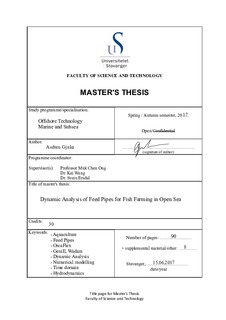| dc.contributor.author | Gjuka, Asdren | |
| dc.date.accessioned | 2017-10-13T12:43:12Z | |
| dc.date.available | 2017-10-13T12:43:12Z | |
| dc.date.issued | 2017-06-15 | |
| dc.identifier.uri | http://hdl.handle.net/11250/2460089 | |
| dc.description | Master's thesis in Offshore technology: Marine and subsea technology | nb_NO |
| dc.description.abstract | The demand for seafood is continuously growing throughout the world, while the number of sheltered locations for fish farming is decreasing. Consequently, the industry is pushed to fin nd new and innovative solutions to this problem. One solution is to move the fish farms in non-sheltered locations, which requires extensive research on all structural parts of a fish farm, including components of the feeding system. The main goal of this thesis is to predict the hydrodynamic loads on feed pipes used by fish farmers in the industry, which is an important aspect of design to assure successful operation. The aquaculture industry has expressed the need for increasing the knowledge on feed pipes for fish farming. The bending of the pipes is of particular concern, especially when introducing non-sheltered locations. The hydrodynamic loads of the feed barge were obtained by generating a finite element model in GeniE and performing hydrodynamic analysis in frequency domain with the potential solver Wadam. The displacement RAOs of the feed barge were imported into OrcaFlex after conducting a sensitivity-and convergence study to verify the results. Dynamic simulations of the feed pipes were carried out in time domain using OrcaFlex, where the design basis was established using typical environmental and design data for Norwegian salmon farming. Analyses were performed under different sea states, investigating different responses of the feed pipe. Due to the limited work available on the force coefficients for floating pipes on the sea surface, a sensitivity study regarding the force coefficients was carried out. It was concluded to implement a variable data set for the drag-and added mass coe cient of the feed pipes. The results obtained for the selected cases resulted in high loads for all feed pipe lengths.The main problem that was found for the feed pipes was the large bending moment at the connection points, i.e. at the fish cage and the feed barge. For this reason, bend stiffeners at the connection points were installed. A reduction of 846% for the bending moment was observed with the bending stiffener attached to the pipe. To conclude, the dynamic analysis exhibits too large hydrodynamic loads for offshore use. The use of bending stiffeners seems inevitable for the harsh environment in the open sea. More research on the feed pipes must be carried out to secure safe operation offshore. | nb_NO |
| dc.language.iso | eng | nb_NO |
| dc.publisher | University of Stavanger, Norway | nb_NO |
| dc.relation.ispartofseries | Masteroppgave/UIS-TN-IKM/2017; | |
| dc.subject | undervannsteknologi | nb_NO |
| dc.subject | offshore teknologi | nb_NO |
| dc.subject | offshoreteknologi | nb_NO |
| dc.subject | dynamic analysis | nb_NO |
| dc.subject | aquaculture | nb_NO |
| dc.subject | akvakultur | nb_NO |
| dc.subject | fish farming | nb_NO |
| dc.subject | sjømat | nb_NO |
| dc.title | Dynamic Analysis of Feed Pipes for Fish Farming in Open Sea | nb_NO |
| dc.type | Master thesis | nb_NO |
| dc.subject.nsi | VDP::Teknologi: 500::Marin teknologi: 580::Offshoreteknologi: 581 | nb_NO |
